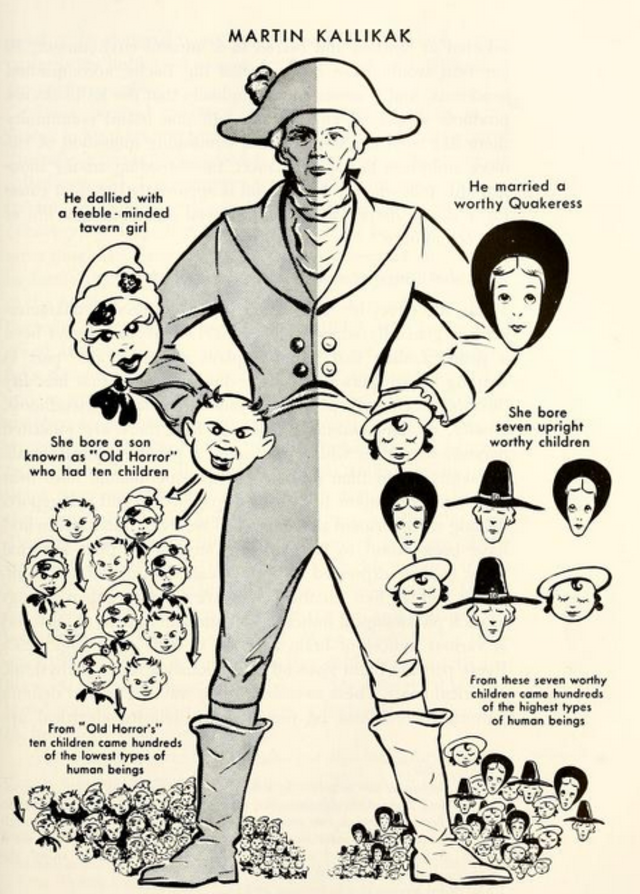3.1 Chapter Overview and Learning Objectives
3.1.1 Learning Objectives
After reading this chapter, students will be able to do the following:
- Identify the origins of criminology.
- Recognize the origins of theories of criminology in the classical and positive schools.
- Analyze the broader context of what led to different schools of thought being embraced at their time in history.
- Debate the credibility of each theory’s claims.
- Explain the modern interpretation of biological influences on crime.
3.1.2 True Crime Stories: Genocide and Criminology

Figure 3.1 Deborah Kallikak pictured at the New Jersey Home for the Education and Care of Feebleminded Children.
Deborah Kallikak (figure 3.1) came to fame in 1912 when American psychologist Henry Goddard made her and generations of her family an example for his argument in favor of eugenics (controlled human reproduction). He believed anyone with undesirable characteristics should not be allowed to reproduce. Goddard claimed Deborah’s family and, in fact, generations of Kallikaks had produced people who were poor, criminal, mentally ill, and intellectually disabled. He argued that stopping the women in this family from being able to have children could have saved society money and protected them from harm. In his book, he claimed to have traced the Kallikak family back generations to determine the exact point in which the gene pool was sullied. The patriarch of this family tree, Martin Kallikak, had an affair with a barmaid. The children produced from his wife were “good” and the children produced from the barmaid were bad” – for generations. 
Figure 3.2 Caricature of the Kallikak Family tree.
Goddard ran an institution for “feebleminded” children (those with intellectual disabilities, learning disabilities, and mental illness). It was there he studied Deborah Kallikak, great-great-great granddaughter of Martin and the barmaid. He allegedly traced the family tree to find that the descendants of Martin and his wife were intelligent, morally upstanding, successful members of the community (figure 3.2). However, those who descended from the trist with the barmaid were morally repugnant criminals and those who were a drain on society. Goddard’s book was a huge success and was used by eugenics supporters worldwide to justify the forced sterilization or murder of those they determined to be undesirable.
Genocide—or the killing of people based on their racial, ethnic, national, or religious origin—is widely considered one of the worst crimes against humanity. From 1941 to 1945, millions of Jews, Gypsies, and other members of “undesirable” groups were murdered across Nazi-occupied Europe. In the decade leading up to the Holocaust, Nazi ideology about “racial purity” was anchored in the growing field of criminal anthropology, which argued that criminal behavior was (1) caused by defective biology rather than social or environmental factors (like poverty), and (2) heritable, passed from grandparents to parents to children, across multiple generations (Rafter, 2008). Criminal anthropology was also widely cited in America to promote efforts to control human breeding, to solve social problems such as crime. Goddard was a solid member of this group of eugenicists and the American eugenics movement. The founder of criminal anthropology, Cesare Lombroso, was actually a liberal social reformer who believed in the importance of both biological and environmental factors to explain criminal behavior. He also advocated for therapeutic solutions to address crime. However, his legacy is deeply intertwined with Nazi genocide and the American eugenics movement, which we’ll discuss later in this chapter. To understand how these ideas took hold, it is important to go back to the origins of criminology.
3.1.3 Licenses and Attributions for Chapter Overview and Learning Objectives
“Chapter Overview and Learning Objectives” by Mauri Matsuda is licensed under CC BY 4.0.
Figure 3.1 Deborah Kallikak pictured at the New Jersey Home for the Education and Care of Feebleminded Children is in the Public domain.
Figure 3.2 Caricature of the Kallikak Family tree is in the Public domain.
